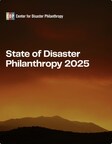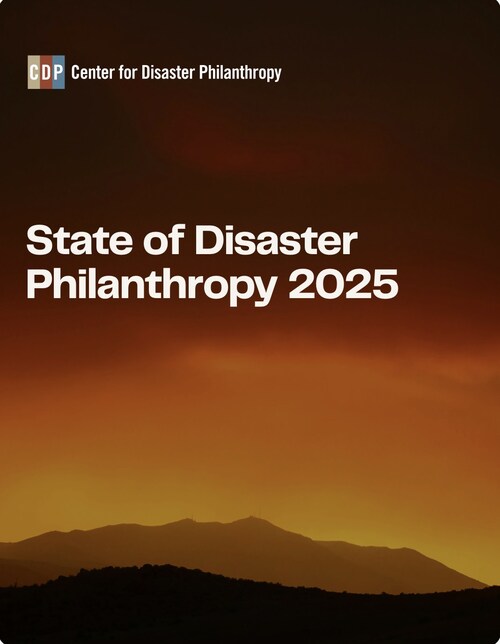CDP offers three recommendations on how philanthropy can respond to a shifting disaster landscape to maximize impact
WASHINGTON, Nov. 18, 2025 /PRNewswire-PRWeb/ -- A new report by the Center for Disaster Philanthropy (CDP) released today finds that while overall philanthropic giving for disaster and humanitarian crises declined in 2023, funding for resilience building and long-term recovery grew. These results signal a possible shift toward more strategic disaster philanthropy.
The State of Disaster Philanthropy 2025 report, which uses Candid's most complete full-year data, shows that private and community foundations, corporations (including corporate giving programs), public charities, and other grantmaking organizations and individuals contributed $1.2 billion to disasters and humanitarian emergencies in 2023, supporting communities affected by wildfires, earthquakes and humanitarian crises worldwide. While significant, this amount represented less than 1% of reported charitable giving, revealing the wide gap between growing needs and available funding.
"Philanthropy can move quickly, flexibly and in partnership with communities before and after a disaster," said Patricia McIlreavy, CDP's president and CEO. "More and more donors are rethinking not just how they respond, but how they prepare — taking a long-term, community-led approach that aligns with their values and resources. As disasters grow in frequency, scale and cost, we need philanthropy to remain generous and harness its strengths to address rising global needs."
Among the report's other key findings:
- Disasters caused by severe weather and natural hazards, such as the Maui wildfires and the Turkey-Syria and Morocco earthquakes, drove overall philanthropic giving in 2023. These accounted for nearly 30% of all disaster funding, up from 10.8% in 2022.
- Support for long-term recovery and resilience increased. Reconstruction and recovery funding reached 12.7% of disaster giving, its largest share since 2018. The proportion of resilience, risk reduction and mitigation funding tripled to 6% of total disaster giving, up from 2.1% in 2022.
- Local organizations received a notable share of support. Nearly one-third of all global disaster funding went directly to organizations headquartered in the countries where the work took place, exceeding the 25% target set by the global Grand Bargain on local humanitarian funding. Direct global giving accounted for 71.6% of all international disaster transactions.
- Complex humanitarian emergencies (CHEs) saw a decline, but there's hope. The share of funding for CHEs dropped from 17.4% of total disaster giving in 2022 to 10.1% in 2023, following unprecedented support for Ukraine the previous year. However, CHE giving in 2023 remained significantly higher than pre-2022 averages.
- Giving by the largest U.S. community, corporate, independent and operating foundations declined from 2022, but showed a steady expansion over time. Candid's Foundation 1000 data set found that funding for disasters in 2023 was $318.6 million, the second-highest amount since our tracking began in 2012. Only 2022 saw more funding or grants than 2023.
Meeting the needs of 2025 disasters
CDP's research team also interviewed more than a dozen philanthropy leaders who shared how they are adapting to the growing needs resulting from disasters amid cuts in government funding that are affecting communities worldwide. Many expressed their commitment to their communities, taking action and learning as they navigate internal and external constraints in their organizations.
Strategic disaster giving practices that donors can adopt now
CDP identified three ways donors can leverage their strengths to boost the impact of their disaster giving:
- Address immediate needs but always take the long view. Provide philanthropic support when a disaster strikes, but also contribute to longer-term efforts that enable communities to rebuild and recover stronger.
- Invest in local organizations. As CDP notes in the report, "People and organizations close to disasters and humanitarian emergencies have skills and wisdom to lead effective relief, recovery and mitigation efforts."
- Seek out opportunities to coordinate and collaborate. Harness connections with existing and new community members and peers before and after a disaster.
The full State of Disaster Philanthropy 2025 report, which includes information about the data and methodology, is available on CDP's website.
About the Center for Disaster Philanthropy
CDP mobilizes philanthropy to strengthen communities' ability to withstand disasters and recover equitably when they occur. It provides expert advice and educational resources, supports diverse coalitions and manages domestic and international disaster funds on behalf of corporations, foundations and individuals through targeted, holistic and localized grantmaking. Find out more at disasterphilanthropy.org and on X and LinkedIn.
Media Contact
Kristina Moore, Center for Disaster Philanthropy, 1 (720) 583-5325, [email protected], https://disasterphilanthropy.org/
SOURCE Center for Disaster Philanthropy



Share this article